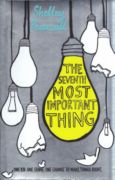
The Seventh Most Important Thing
Written by Shelley Pearsall
Alfred A. Knopf, 2015, 278 pp.
ISBN 9780533497281
On the other side, he found seven letters carefully cut out of silver metallic foil and glued on the cardboard, which had been covered with purple paper. Arthur’s breath caught in his throat as he read them. The seven letters spelled out two words: FEAR NOT (p.265)
This realistic middle grade novel set in Washington, D.C. addresses loss, grief, and the healing power of art and community. The death of a parent is life-altering, and no one knows that better than Arthur T. Owens, the thirteen-year-old protagonist in this heart-wrenching and hopeful contemporary novel. At the start of the story, Arthur’s father has been killed in a motorcycle accident. Arthur doesn’t know if Dad, who was no angel, has gone to heaven: “Arthur wasn’t sure. About heaven or anything else. He had a lot of doubts.” His grief turns to anger in need of a target—and he hurls a brick at the Junk Man, a vagrant who forages in trash cans. Arthur has a reason for this terrible act. Still, he is arrested and briefly held in juvenile hall. Fortunately, the Junk Man, aka Mr. Hampton, convinces the judge to sentence Arthur to 120 hours of community service. Arthur has to collect “seven important things: “light bulbs, foil, mirrors, pieces of wood, glass bottles, coffee cans, cardboard” for the Junk Man’s art project, his vision of heaven.
Young people who have experienced a serious loss will read The Seventh Most Important Thing with empathy and interest. Through the story’s twists and turns, they will stay on board with Arthur, whose authentic teenage voice mixes toughness, hurt, and humor. Only by learning to be honest with himself and others will he overcome his grief. A loner, he gradually starts to let others in. With his new friend Squeak’s help, Arthur pushes a grocery cart through snow and rain to scavenge the Junk Man’s objects. His determination to fulfill his duties for the Junk Man becomes an appreciation for art’s ability to rise above death and a sense of community with the people (including his stern but soft-hearted parole officer and tattoo artist) in his life. The clock is ticking, though. There will be another death in the story, and more unexpected changes in Arthur’s family.
A novel about grief, the power of art, and the need to trust others, it is also about the slow, painful steps a family takes to heal after a death. No wonder Pearsall’s central message is “Fear Not.” As any person who has lost a loved one knows, the hardest part can be finding the courage to be happy again–and Arthur finally does that. The book can be paired with two other excellent middle grade novels about coping with death, The Thing about Jellyfish (Ali Benjamin, 2015), and Counting by 7s (Holly Sloan, 2013). Readers interested in texts that explore the power of art might also like Under the Egg, (Laura M. Fitzgerald, 2014) and Half a Chance (Cynthia Lord, 2014).
Shelley Pearsall was a middle school teacher before becoming the author of many acclaimed novels for young people. Her first novel, Trouble Don’t Last (2003), won the Scott O’Dell Award for Historical Fiction. Pearsall explains that the art in The Seventh Most Important Thing is based on the work of American folk artist James Hampton, who collected junk from the street to build his “vision of heaven,” a permanent exhibit at the Smithsonian American Art Museum. Although Pearsall imagined her story, the truth in the fiction makes The Seventh Most Important Thing all the more intriguing and a standout novel to share with young readers.
Ann Malaspina, Vermont College of Fine Arts
WOW Review, Volume VIII, Issue 2 by Worlds of Words is licensed under a Creative Commons Attribution-NonCommercial-ShareAlike 4.0 International License. Based on work at https://wowlit.org/on-line-publications/review/viii-2/
